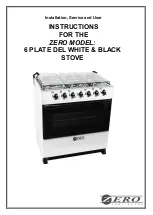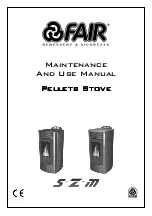
combustion. In all cases, the flue must be relined with a listed liner system, such as HomeSaver
Chimney Liner. If your masonry built chimney contains oversized flue tiles it must be relined to
ensure proper draft. This means that a new, properly sized liner system must be installed before
connection to the Crossfire stove is completed. Again, for 10 feet or less a 3 inch stainless steel liner
can be used with the Crossfire. For lengths greater than 10 feet, a 4 inch stainless steel liner is to be
used. It is also strongly recommended that these stainless steel liners be fully wrapped in insulation.
This insulation will limit moisture buildup and ensure better performance of the Crossfire stove.
Country Flame strongly recommends the use of smoke and carbon monoxide detectors when installing
the Crossfire. Always refer to local codes and a professional installer to ensure proper installation.
FLOOR PROTECTION REQUIREMENTS
1.
A Country Flame Crossfire insert may require a listed floor protector that is noncombustible.
Refer to TABLE 3 on page 27 of this manual to ensure all clearances to combustible material
are met during the installation of a Crossfire stove. Ensure that any noncombustible floor
protection equals or exceeds R = 1.5 or greater. Refer to TABLE 3 for floor protector clearance
requirements.
2.
If a floor protector, different from the tested floor protector, is to be used, it must meet or
exceed the requirements of the listed R-value of the tested floor protector. To convert alternate
floor protectors to their respective R value use the following procedures:
a.
Convert floor material specification to R-value.
i.
R-value is given – no conversion is required.
ii.
k-factor is given with required thickness (T) in inches: R = (1/k) x T.
iii.
C-factor given: R = 1/C.
b.
Determine the R-value of the proposed alternate floor protector.
i.
Use the formulas provided in STEP 2a to convert values not expressed as “R.”
ii.
For multiple layers of material, add each R-value of each layer to determine the
materials overall R-Value.
c.
If the overall R-value of the alternate material is greater than the R-value tested
material defined in STEP 1, then the alternate floor protection is acceptable.
d.
EXAMPLE
:
i.
The tested material was ¾-inch thick with a k-factor of 0.84.
ii.
The R-value of the tested material was R = (1/0.84) x 3/4 = 0.893.
iii.
The proposed alternative floor protector is 4-inch brick material with a C-factor
of 1.25 over 1/8-inch mineral board with k-factor of .29.
iv.
The 4-inch brick material has a value of R
brick
= (1/1.25) = 0.80.
v.
The mineral board has a value of R
mnbrd
= 1/0.29 x 0.125 = 0.431
vi.
Total R
brick
+ R
mnbrd
= 0.80 + 0.431 = 1.231.
vii.
Since the total R-value of the alternate example floor protector (R=1.231) is
greater than the tested example floor protector (R=0.893), the alternate is
acceptable.
3.
Listed Floor Protector Definitions:
a.
Thermal Conductance = C = Btu/(hr)(ft
2
)(
O
F) = W/(m
2
)(
O
K)
b.
Thermal Conductivity = k = (Btu)(inch)/(hr)(ft
2
)(
O
F) = W/(m)(
O
K) = Btu/(hr)(ft)(
O
F)
c.
Thermal Resistance = R = (ft
2
)(hr)(
O
F)/Btu = (m
2
)(
O
K)/W
4.
Install in accordance with 24 CFR, Part 3280 (HUD).
Version
2.0fc
31
5.
WARNING:
Crossfire insert stoves must always be placed on a listed floor protector if the
existing floor where the stove is to be placed is made of any combustible material. Never allow
















































